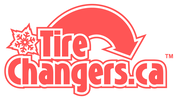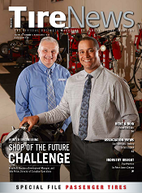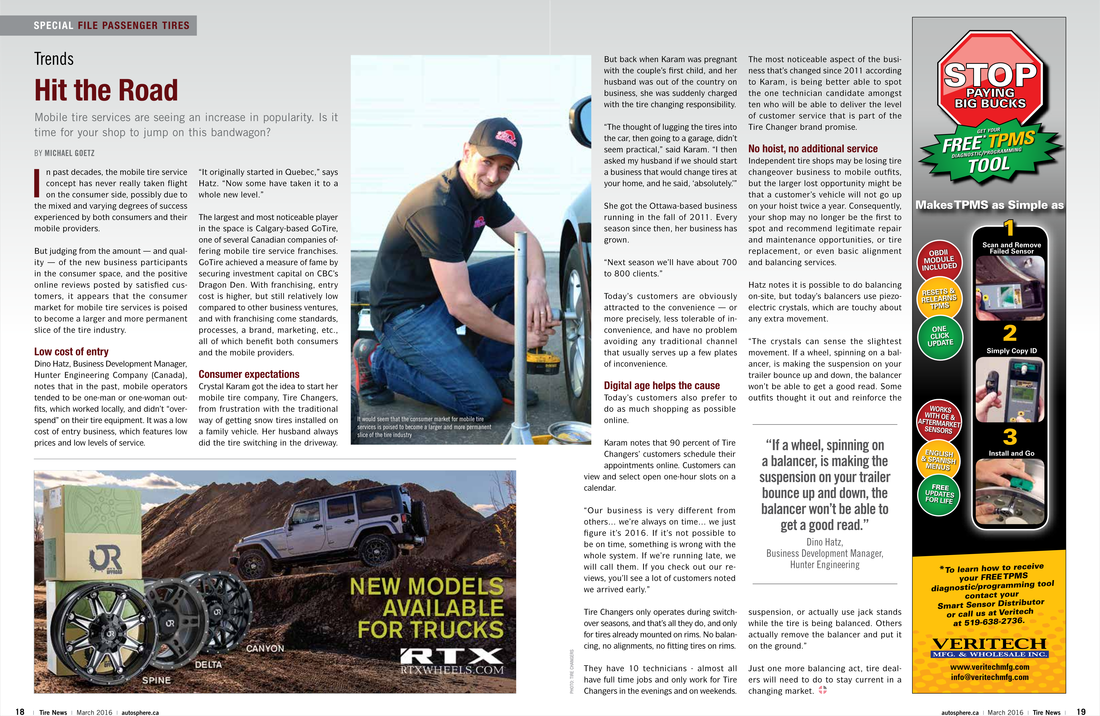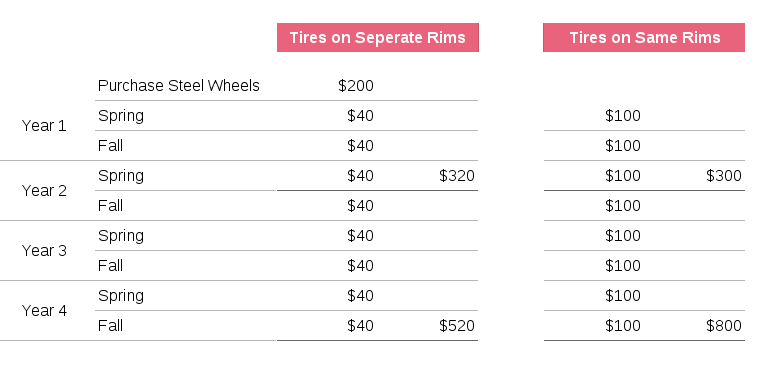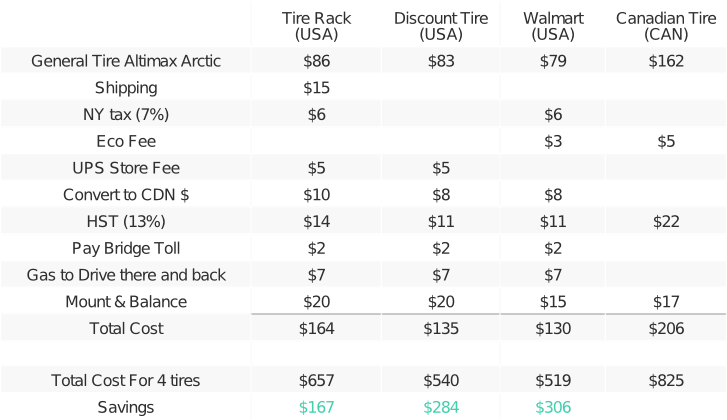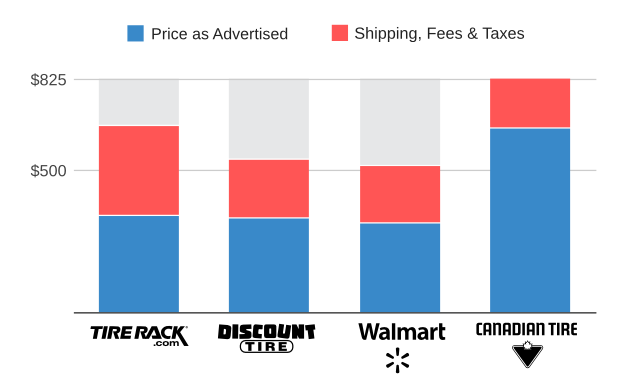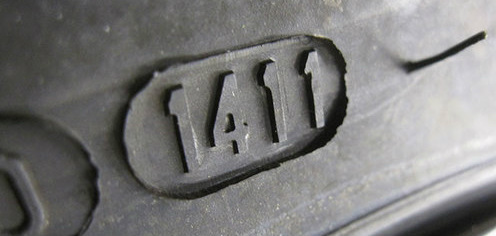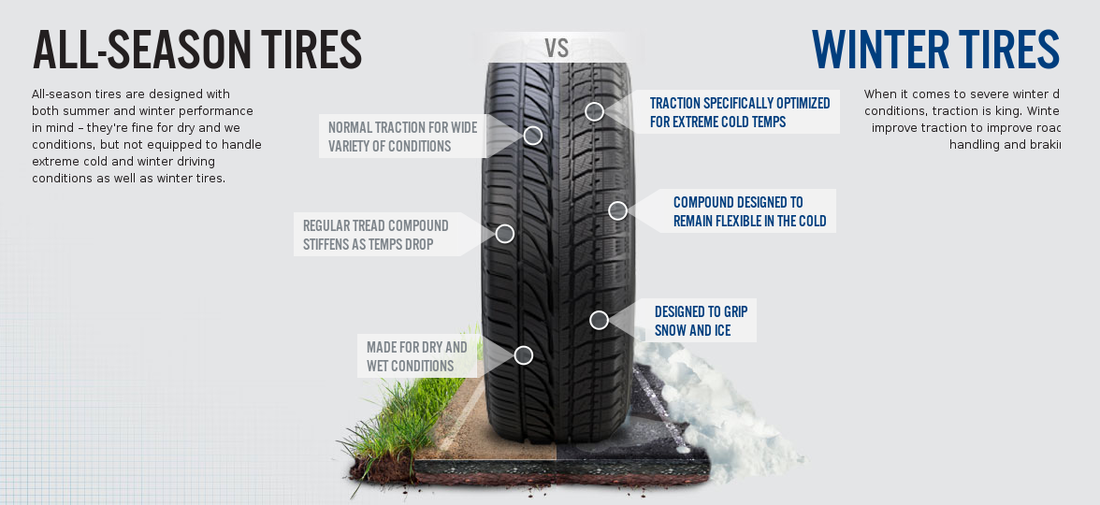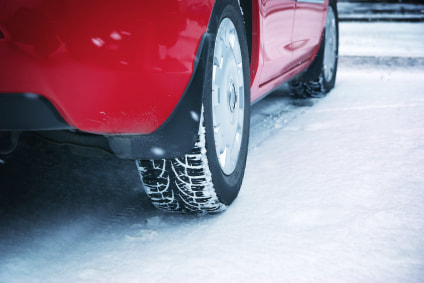2 Comments
Here we can see that the break even point occurs after only 1-1/2 years! Furthermore, after 4 years the savings add up to $280, definitely not pocket change! So if you're one of the smart ones out there with winter tires on separate rims, you can now tell your co-workers that you're saving a pile of money and you have the added convenience of having Tire Changers come to your home :) 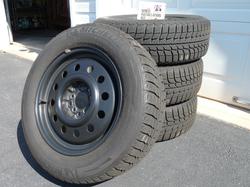 It seems like many drivers out there use steel (black) rims for their winter tires, let's find out why. We called our local Canadian Tire to get prices for averaged sized steel rims, the cost was about $200 for 4 steel rims, aka 'steelies'. The charge for a tire changeover on separate rims was $40 and the charge for a tire changeover with one set of rims was $100. The cost for a tire changeover with one set of rims is higher because mounting tires on a single set of rims take a much longer and is more labour intensive. Each off-season tire would need to be removed from the rim, then the in-season tire would have to be put back on the rim, and then the tire and rim would need to be re-balanced (balancing is a process by which small weights are added to the rim so that the complete tire and rim roll smoothly). Let's see how much it will cost after a few years in both cases...
How to Buy Tires from the USA for the Biggest Savings
It’s no secret that the price of tires in the Unites States are cheaper than here in Canada; the real question is ‘How big of a discount are we talking here?’ and then ‘You had me at ‘big discount’, how to?’. To make it easy I’m going to select a popular tire size (215/60-16) for my comparison. You may have a different tire size but the end results will likely be similar. I live in Ottawa, ON and the closest American city is Ogdensburg, NY, which is about a 50 minute drive. Similar results will apply if you live in any Canadian city close to the US border. To buy tires from the USA, I usually head over to these popular websites: TireRack.com, DiscountTire.com and Walmart.com. Obviously there are plenty other options, but these three tire retailers will make my point. If you’re buying from Tire Rack or Discount Tire, you will need to have the tires shipped to an American address. Businesses that can act as your US address, like the UPS store in Ogdensburg, will accept parcels on your behalf for a small fee. If you’re buying from Walmart.com, they will ship any item on their website to any American Walmart store for free (they call it ‘site to store’). Getting back to the tire price comparison. I mentioned a popular tire size of 215/60-16. I’m also going to choose a very popular winter tire, General Tire Altimax Arctic. It was pretty easy to find this tire/size combination across every website for the comparison. Next, I’m going to compare tire prices from our American friends to the tire prices at Canadian Tire. Keep in mind that this chart should serve as a general reference, as every store has sales and discounts from time to time. The table below includes all of the costs associated with buying tires in Canada and in the USA.
*Initial tire prices are in the currency of store location. All prices are based per tire assuming a set of 4 tires will be purchased (eg. cost of toll fee and gas has been divided by 4).
Some interesting things to note are that Tire Rack adds a delivery charge and NY sales tax at checkout, while Discount Tire does not charge for shipping and does not charge state tax. All prices have been converted to Canadian Dollars for an apple-to-apple comparison (exchange rate at time of writing USD/CDN: 1.09). Furthermore, if you want to have your tires mounted and balanced, the American Walmart store will do it for $15/tire, watch out though, they will only install tires that are sized according to car manufacturers guidelines. So it’s good to call ahead just to make sure. If you buy from Tire Rack or Discount Tire, bring them home, any local garage can mount and balance for about $20/tire. So there you have it, buying tires from the USA can save you over $300 for one of the most popular tire brands and size. And now you know how to do it for yourself. To help you make it even easier to see the potential discount, I have added a calculator that includes all of the fees and costs required to purchase from the USA. Simply enter the price for one tire from each retailer as advertised and see if it’s worth the effort to buy from the USA. Drop some feedback below and let me know how much money are you able to save on your tires! So how old are my tires anyway? And why should I care? Tires deteriorate over time due to UV and air exposure in a process called outgassing. As the tire ages, the rubber becomes harder and more brittle which can eventually lead to major tire failure like tire-tread separation. Definitely not a good thing. Experts say that tire-tread separation can cause drivers to be involved in serious crashes that could result in death. Manufacturers suggest tires be replaced if they are over 10 years old. It’s not only important to check how old your current tires are but when it comes time to buy new tires you want to check how long they’ve been sitting on the store shelf too. Checking a tires age is actually pretty easy and fun to do. Every tire has a “manufactured-on” date. It’s a 4 digit number found right on the side of the tire. To find it, look for a marking with the letters ‘DOT’, there should be a 4 digit number close by. Something like 1411. The first 2 digits indicate the week of the year the tires were made, so 14 means the 14th week in a calendar year, which would be sometime in April. The last 2 digits indicate the year the tires were made, so 11 would mean there tires were made in the year 2011. Mobile tire-changing companies bring the garage to your door About three years ago, a pregnant Crystal Karam looked out the window at the falling snow and shuddered. With her husband out of town on business and no snow tires on her car, she felt helpless and had no clue who to call. “I thought, ‘Why can’t someone come to my house and put them on?’” 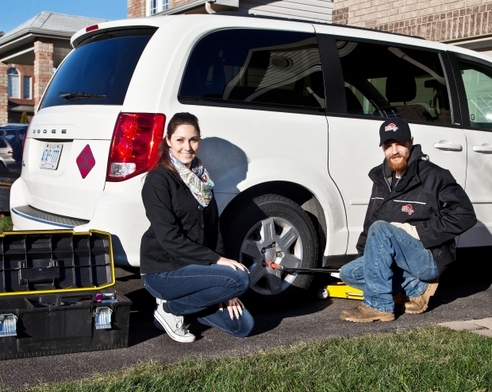 Crystal Karam, owner of Tire Changers, sends technicians, like Bill Rose, to a customer’s home or workplace to change their tires. Photograph by: Bruno Schlumberger , Ottawa Citizen Crystal Karam, owner of Tire Changers, sends technicians, like Bill Rose, to a customer’s home or workplace to change their tires. Photograph by: Bruno Schlumberger , Ottawa Citizen Fast-forward a year later and the young mother of three opened Tire Changers, a mobile tire-changing company that brings the technician to your home or work. “It’s a service of convenience,” says the 30-year-old entrepreneur, whose customers range from single moms and busy families to seniors who don’t want the hassle of lugging heavy tires back and forth to the garage to get them changed over in the fall and spring. For $59, a technician will mount your seasonal tires — they have to be on rims — in your driveway. [The Ottawa Citizen] I hear it all the time, living on the East Coast: "Well, I need an all-wheel drive car because it rains and snows sometimes." But those in the know are well aware that the right kind of rubber is really more important than anything else. This video from the UK's AutoExpress seeks to prove just how true that is. They get two Ford Kugas (Ford Escapes to us Americans), one with front-wheel drive and one with all-wheel drive, and they see which one is better at powering up a snowy slope. The front-drive car doesn't make it very far up the hill with its summer tires — and the all-wheel drive version fails to do any better with the same tires. When equipped with winter tires, the front-driver obliterates the all-wheel drive Kuga that's still stuck on summer tires. The one that does best of all is the all-wheel drive Kuga with winter tires, which makes it all the way up the ski slope. Not surprising. But the video is excellent proof that the tires make all the difference. So the next time someone insists on spending more on an all-wheel drive car and they don't live in some perpetually snow-covered place like Colorado or Alaska, use this to maybe convince them to spend that cash on the right set of tires instead. [Jalopnik]  Last week Tire Changers set up a booth at Canada Post in support of United Way :) On November 1st and 2nd, we will be at Canada Post offering an amazing discount to CP employees. Sign up online through our Onsite events page. Special thanks to Larissa for all her hard work in organizing this event for us! If your work place would be interested in this offer, please contact us for further details  This season Tire Changers and United Way Ottawa are combining their efforts to offer local businesses a unique opportunity to both fundraise and boost productivity! Have your tires changed at work and Tire Changers will donate 10% of all proceeds back to your business' United Way campaign. Employees also receive a significant discount and pay only $40 (40% less than our regular price). Can't get any easier than that! :) Check this link for more details.  What an experience it was to be on our very first talk show! Jason and I had so much fun chatting with Lois and Derick on the Daytime Ottawa show. Check out our segment as we discuss tire basics, booking your appointment online and organizing on-site at work Tire Changeovers. Special thanks to Laura at Rogers 22 for contacting us to be on the show. Spread the word by sharing the segment! Click here to watch |
Stay InformedIf you want to ride the highway of knowledge about vehicle maintenance and awesome car tips, make sure to buckle up and follow our blog. We're your pit stop for all things automotive wisdom, so hop on the info lane and let's fuel up your automotive know-how together! 🚗💨 Archives
February 2024
|
